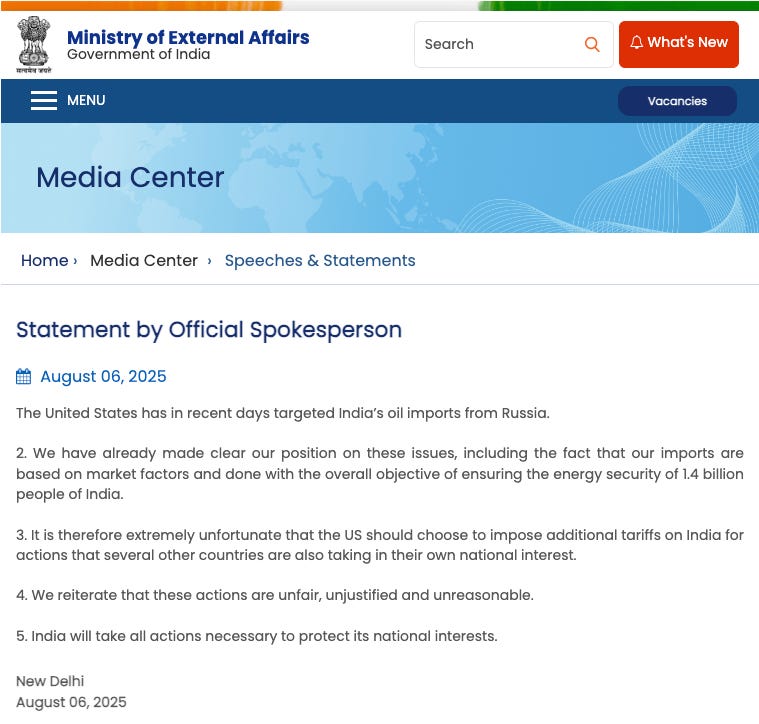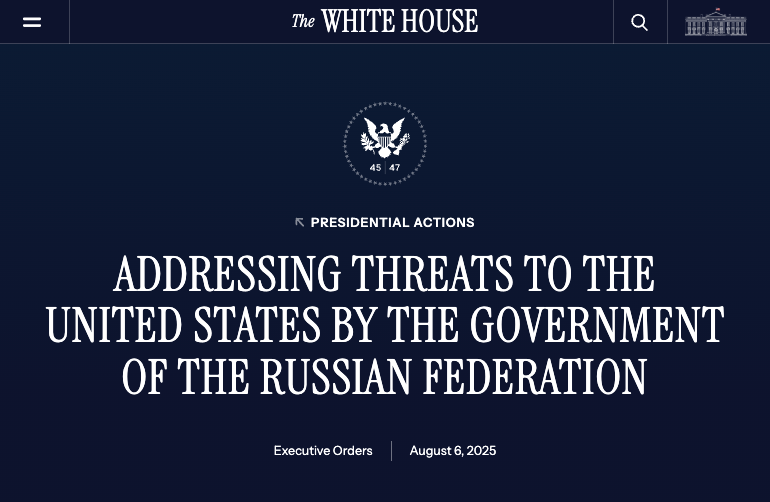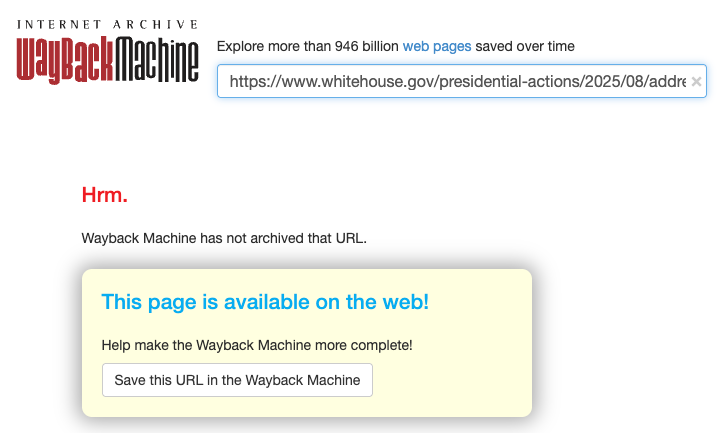Trump's India Tariff Bullshit: Maximum Political Theater, Minimal Strategic Impact 🎭
A new EO targeting New Delhi for Russian oil buys undermines our strategic interests while doing nothing meaningful to counter the Kremlin
President Donald Trump signed a new executive order Wednesday imposing an additional 25% tariff on all Indian goods, raising total tariffs to 50%, citing New Delhi's continued purchases of Russian oil. This marks one of the most sweeping unilateral trade actions against a major partner in recent memory.
The move raises total U.S. tariffs on Indian imports to 50%, among the highest rates imposed on any American trading partner, while demonstrating a fundamental misunderstanding of both effective Russia policy and America's strategic priorities.
Reuters and BBC are describing this policy as straining ties between Trump and Indian Prime Minister Modi to a ‘new low’ and ‘rock bottom’.
What You Need To Know
Trump's tariff tantrum targets the wrong country: A new executive order slaps 50% tariffs on Indian goods over Russian oil purchases—while ignoring China, the EU, and other major buyers of Moscow's energy exports.
Emergency powers abused for political theater: The administration perverts national security authorities to bully a democratic ally rather than actually confronting Russia, setting dangerous precedents for executive overreach.
A gift to Putin wrapped in anti-Russia rhetoric: This policy achieves Moscow's core objective of fracturing American alliances while generating zero pressure on the Kremlin—exactly what Russian strategists would design if they could.
Ukraine abandoned for domestic posturing: The order does nothing for Ukrainian soldiers facing Russian missiles, instead wasting diplomatic resources that could secure actual military aid or enforce existing sanctions.
Incoherent policy reveals strategic bankruptcy: Punishing India while coddling China and ignoring European energy purchases exposes an administration more interested in headlines than results.
Alliance destruction disguised as toughness: The tariffs risk shattering Indo-Pacific partnerships just as competition with China intensifies, potentially driving India toward Beijing and Moscow.
All pain, no gain for American interests: The policy promises market disruption, supply chain chaos, and retaliatory measures while advancing none of the administration's stated goals—the definition of strategic malpractice.
Author’s note: The Internet Archive is not working to serve the URL from the White House at this time, stating “No URL has been captured for this URL prefix” and “Wayback Machine has not archived that URL”, despite the presence of at least six captures as of the time of this writing.
To view the EO, copy and paste the following link into your browser’s address bar:
https://www.whitehouse.gov/presidential-actions/2025/08/addressing-threats-to-the-united-states-by-the-government-of-the-russian-federation
Wild Legal and Strategic Overreach
The EO represents an unprecedented use of the International Emergency Economic Powers Act (IEEPA) to target an ally's energy purchasing decisions rather than direct adversary actions. While this specific order builds on existing Russia-related emergency declarations, its application to punish a strategic partner marks an escalation in Trump's broader use of emergency powers for tariffs, which is a practice that has faced multiple court challenges since February 2025.
The 21-day implementation timeline, effective August 27, creates immediate market disruption across sectors where India serves as a major supplier, including pharmaceuticals, textiles, and information technology services.
Unlike traditional sanctions regimes that focus on constraining hostile actors, this measure bizarrely punishes India, arguably the U.S.’s most strategically important Indo-Pacific partner, for making seemingly-pragmatic energy security decisions that, as they point out in their official response, several of our allies have also made.
India's foreign ministry described Trump’s decision as ‘extremely unfortunate,’ and ‘unfair, unjustified and unreasonable’ while also explicitly noting that India was being singled out and punished for similar actions that "several other countries are also taking in their own national interest."

Incoherent Policy Missing Every Target
The fundamental flaw in Trump's approach lies in its targeting mechanism.
Rather than focusing pressure on Russia (the aggressor state whose war machine depends on energy revenues), the EO punishes India, which has emerged as Moscow's second-largest oil customer. India now accounts for more than 30% of Russian oil exports, up from less than 2% in 2021–22.
While Modi's government maintains what it calls an "all-weather" partnership with Russia dating to the Cold War, New Delhi has consistently emphasized that its energy purchases are driven by securing affordable supplies for its 1.4 billion citizens rather than supporting Moscow's war effort.
Trump has publicly accused India of reselling Russian oil at a profit on the international market—though no clear evidence has been presented to support this claim. The allegation reframes India’s energy policy as profiteering, further justifying the tariffs in the administration’s rhetoric even as the EO itself makes no mention of resales.
The targeting becomes more puzzling when considering that European Union countries continue purchasing Russian energy, fertilizers, and chemicals. Several European Union members, including Hungary, Slovakia, and Austria, continue to import Russian gas and oil under existing exemptions—none of which have triggered U.S. tariff actions. Turkey has also become a major buyer of Russian crude for its own energy security needs.
Notably absent from the order is any mention of China, Russia's largest trading partner and energy customer. This selective enforcement undermines the policy's stated objectives while creating obvious inconsistencies in application.
This Policy Serves Putin's Objectives
Rather than constraining Moscow, the tariff regime advances several key Russian strategic objectives. First, it fractures critical U.S. partnerships at precisely the moment when coalition building is essential for effective Russia containment. As former Indian trade official Ajay Srivastava remarked to the New York Times, the action will likely "push India to reconsider its strategic alignment, deepening ties with Russia, China and many other countries."
Second, it validates Russian narratives about American economic coercion that resonate throughout developing nations and non-aligned countries. Moscow's propaganda apparatus can now point to concrete evidence of U.S. unilateral punishment of countries making sovereign economic decisions, undermining broader efforts to isolate Russia diplomatically.
Third, it creates new tensions that distract from Ukraine's immediate battlefield needs. Every diplomatic hour spent managing the fallout from deteriorating U.S.-India relations represents time not spent on coordinating military assistance or closing actual loopholes in the application of sanctions.
Fracturing Partnerships
The timing of this trade escalation could hardly be worse for American strategic interests. Prime Minister Modi is preparing for his first visit to China in over seven years, suggesting potential realignment possibilities just as U.S.-China competition intensifies. The tariffs risk breaking the Quad partnership (U.S., India, Japan, Australia) and undermining broader Indo-Pacific strategy designed to counter Chinese influence.
The economic disruption extends beyond bilateral trade. With U.S.-India trade worth over $190 billion annually, the tariffs threaten to drag India's GDP growth below 6% this year, according to HDFC Bank economist Sakshi Gupta. Indian exporters warn that a majority of shipments to the U.S. will be affected, with estimates ranging from 55% to 87% depending on the sector, placing them at a 30-35% disadvantage versus competitors in Vietnam, Bangladesh, and Japan.
In contrast, the administration is reportedly finalizing an agreement with Apple exempting certain iPhone components from new tariffs in exchange for a $100 billion domestic manufacturing pledge. The move underscores the administration’s willingness to accommodate corporate interests while imposing sweeping penalties on a key democratic partner.
How Real Pressure Would Look
If this administration were genuinely committed to degrading Russian war-making capacity rather than generating headlines, effective measures might target:
Russian energy infrastructure directly: Refineries, pipelines, and export terminals that generate revenue for Moscow's war machine
Chinese financial institutions: Banks processing Russian payments that enable sanctions circumvention
Critical technology exports: Components essential for Russian weapons systems and military production
Coordinated G7 enforcement: Strengthening existing price caps and closing loopholes through multilateral cooperation
The order also instructs the State Department to compile a list of countries still importing Russian oil and recommend whether additional trade actions should be taken, potentially widening the scope of this approach far beyond India.
Tariffs on India Don’t Benefit Ukraine
Most critically for Trump's stated goal of ending the war in Ukraine, this executive order provides zero meaningful assistance to Ukrainian forces. Ukrainian battlefield effectiveness isn't constrained by Indian trade policy but depends on air defense systems, long-range precision missiles, and sustained military aid that this policy does nothing to provide.
Despite today’s meeting between Putin and Trump's envoy Steve Witkoff, with the president claiming "great progress was made," White House officials have also confirmed that secondary sanctions against Russia remain scheduled for Friday. This visible disconnect between diplomatic engagement with Moscow and economic pressure on New Delhi highlights the overall incoherent nature of the administration's approach.
The tragedy is that meaningful Ukraine support requires precisely the kind of sustained alliance cooperation that this EO actively undermines. Every dollar of economic disruption created by these tariffs could have been better invested in actual military assistance or diplomatic coordination with allies.
Author's note: I am not a financial analyst, and am not equipped to provide analysis of the economic outcomes associated with this EO.
However, based on patterns from previous Trump administration tariff actions, we can expect significant market volatility, supply chain disruptions, and retaliatory measures that typically harm American consumers and businesses while failing to achieve stated policy objectives.
Actions Have Consequences
The executive order sets in motion several predictable outcomes, none of which advance stated U.S. interests:
Short-term (3-6 months): Market volatility across pharmaceutical and technology sectors; likely Indian retaliation targeting U.S. agricultural or technology exports; pressure on other Russian oil importers as they anticipate similar treatment.
Medium-term (6-18 months): Acceleration of Indian de-dollarization efforts and BRICS economic integration; Russian oil finding alternative routes through China, Turkey, and/or other willing buyers; Congressional and legal challenges to the EO's scope.
Longer-term strategic implications: Breaking of Indo-Pacific partnerships just as competition with China intensifies; validation of authoritarian narratives about American unreliability; reduced effectiveness of multilateral sanctions regimes.
The cascading consequences of this policy offer no plausible pathway to improved U.S. strategic positioning. Given Trump's pattern of issuing dramatic executive orders only to reverse or modify them under pressure, this tariff regime may prove temporary rather than representing durable American policy.
The order appears to serve dual purposes: domestic political theater designed to project strength against Russia and economic coercion intended to force India's compliance on energy purchases.
Neither approach addresses the fundamental strategic challenge of effectively constraining Russian war-making capabilities while also maintaining our critical partnerships in an era of serious great power competition.
In plain terms: it’s indefensible.
Strategic Incompetence
The EO represents the substitution of easy symbolism for hard strategic thinking. It is clearly designed to generate domestic political credit for "confronting Russia" while avoiding genuinely difficult decisions that might actually change the war's trajectory, such as authorizing Ukrainian strikes on Russian territory or further risking our economic relationship with China.
The policy's contradictions are so glaring, that one begins to wonder whether this level of strategic incompetence could truly be entirely accidental. The administration appears more committed to pressuring a democratic ally than the brutal authoritarian regime currently waging a hot war in Europe and destabilizing the globe.
The fundamental contradiction at the heart of this policy is that it punishes pragmatic allies for making rational economic decisions while leaving the world's primary enablers of Russian aggression untouched. As Trump simultaneously praised his envoy's "highly productive meeting" with Putin, the administration appeared far more interested in pressuring New Delhi than Moscow.
For an administration that claims to prioritize America's strategic interests and ending the war in Ukraine, this EO achieves neither objective.
Instead, it advances Russian strategic goals by fracturing critical partnerships, validating authoritarian narratives about American overreach, and distracting from Ukraine's actual needs—all while generating maximum political theater and minimal strategic impact.
The Kremlin is probably celebrating this order, not because it fears its economic consequences, but because it so clearly advances Putin's broader objective of dividing America from its partners.
In the complex chess game of great power competition, Trump has just sacrificed a queen to threaten a pawn.






